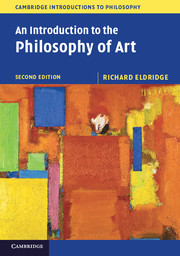Book contents
- Frontmatter
- Contents
- Acknowledgments
- Preface to the second edition
- 1 The situation and tasks of the philosophy of art
- 2 Representation, imitation, and resemblance
- 3 Beauty and form
- 4 Expression
- 5 Originality and imagination
- 6 Understanding art
- 7 Identifying and evaluating art
- 8 Art and emotion
- 9 Art and morality
- 10 Art and society: some contemporary practices of art
- 11 Epilogue: the evidence of things not seen
- Bibliography
- Index
- References
9 - Art and morality
Published online by Cambridge University Press: 05 June 2014
- Frontmatter
- Contents
- Acknowledgments
- Preface to the second edition
- 1 The situation and tasks of the philosophy of art
- 2 Representation, imitation, and resemblance
- 3 Beauty and form
- 4 Expression
- 5 Originality and imagination
- 6 Understanding art
- 7 Identifying and evaluating art
- 8 Art and emotion
- 9 Art and morality
- 10 Art and society: some contemporary practices of art
- 11 Epilogue: the evidence of things not seen
- Bibliography
- Index
- References
Summary
Some controversial cases: Mapplethorpe, Serrano, Finley, and others
In 1989 national protests erupted in response to a decision by the US-government-funded National Endowment for the Arts to support exhibitions featuring Robert Mapplethorpe, whose work included homoerotic photographs, and Andres Serrano, whose work included Piss Christ, a 5 foot by 3 foot photograph of a wood and plastic crucifix floating suspended in the artist’s urine. In response to the protests, Congress enacted a law directing the NEA to “take into consideration general standards of decency and respect for the diverse beliefs and values of the American public” in awarding grants.
In June 1990 NEA chairman John Frohnmayer, citing this law and describing their work as “indecent,” then vetoed awards to four artists – Karen Finley, Holly Hughes, Tim Miller, and John Fleck – that had been recommended by a NEA peer review panel. Hughes, Miller, and Fleck are gay and deal with homosexual issues in their work. Finley’s most notorious work is her 1989 performance piece We Keep Our Victims Ready, inspired by the case of Tawana Brawley, a 15-year-old girl who was found on November 28, 1987 alive near her home in upstate New York, covered with feces and wearing only a Hefty trash bag. Ms. Brawley claimed to have been abducted and assaulted by three or six white police officers. After several weeks of investigation, a grand jury concluded “there is nothing in regard to Tawana Brawley’s appearance on November 28 that is inconsistent with this condition having been self-inflicted.” In her performance piece, Finley asks about Brawley’s staging of her abduction and discovery: “Was this the best choice? What was the worst choice? What was the other choice? All of us have that moment where puttin’ the shit on us is the best choice we have.” At the end of the piece, after smearing herself with feces-symbolic chocolate, Finley covers herself with tinsel because, she says, “no matter how bad a woman is treated, she still knows how to get dressed for dinner.”
- Type
- Chapter
- Information
- An Introduction to the Philosophy of Art , pp. 225 - 252Publisher: Cambridge University PressPrint publication year: 2014

